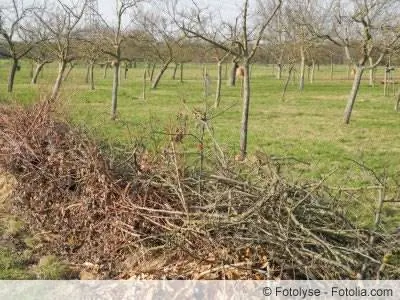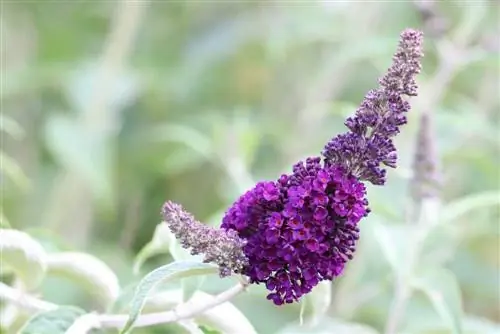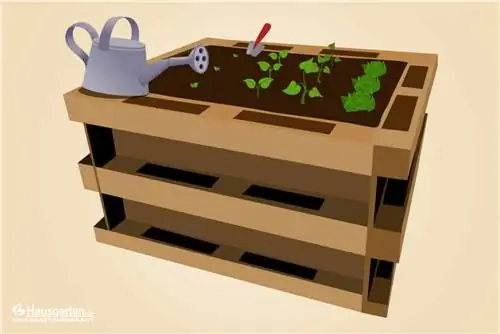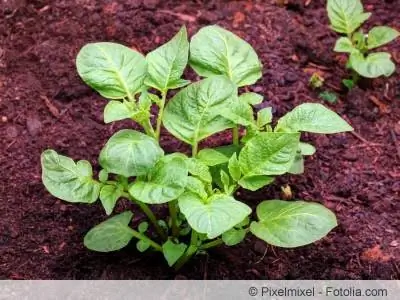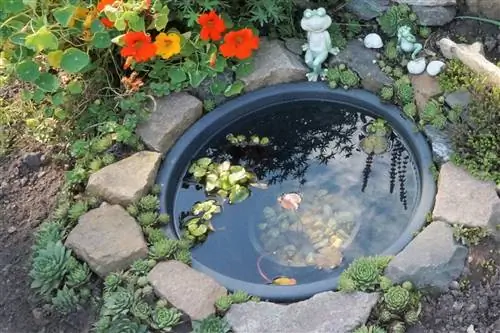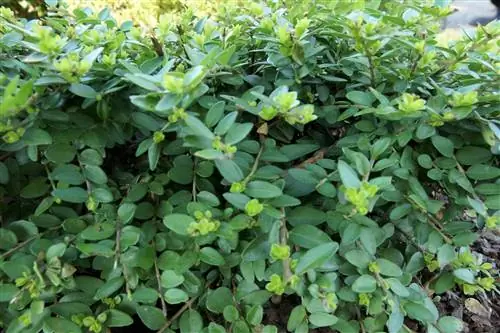- Author admin [email protected].
- Public 2023-12-17 03:39.
- Last modified 2025-01-24 12:45.
Environmental protection and also species protection is a topic that is becoming more and more important. The changes in our environment, the intensive development of many regions and the entire industrialization have contributed to the disappearance of natural habitats. With a Benje hedge, every hobby gardener can make an enormous contribution to environmental and species protection.
The Benje hedge is also known as a deadwood hedge. What is very pleasant for hobby gardeners is that by creating such a hedge they can create an ecologically valuable plant in their own garden without any financial outlay. In addition, dead wood can also be recycled without having to be shredded.
What does the Benje hedge look like?
Benje hedges are also known as deadwood hedges. They are characterized by loose deposits of predominantly thin woody cuttings made from branches and twigs, which in turn promote initial planting within the seeds. Benje hedges became popular in the 1980s when their namesake, Hermann Benjes, first wrote about this new garden architecture. On the one hand, the Benje hedge promotes initial planting and thus the preservation of naturally reproducing plant species. On the other hand, such a hedge offers birds and other animals protection as well as food. In return, the animals significantly promote the seeding of the trees by depositing feces and creating food deposits within the Benje hedge.
The construction principle of the Benje hedge
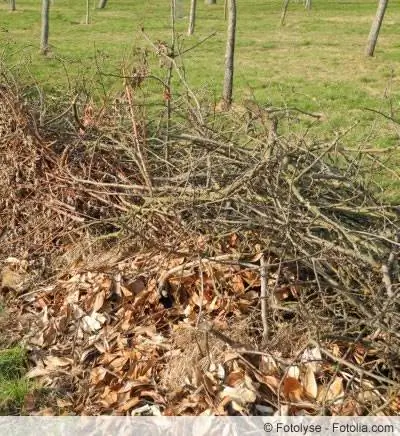
To create a Benje hedge, wood cuttings made from brushwood, branches and twigs are either mixed up or loosely stacked in strips or in a pile or as a wall, or simply dumped at the desired location. The Benje hedge is intended, among other things, to protect growing plants. The advantages of designing a Benje hedge are that it is very inexpensive to create because no plants are purchased for this purpose, but rather the existing seeds from the pruning are used to plant additional plants. In addition, the cuttings that are usually produced as garden waste are put to good use. The loosely stored dead wood also provides direct habitat for various bird species as well as insects and small acid animals. The Benje hedge, which became popular in the 1980s, became so popular in the early 1990s that the creation of these hedges was propagated and promoted as a ministerial decree.
Advantages / best location
The installation of the Benje hedge is particularly useful wherever it makes a valuable contribution to the biotope quickly and inexpensively in a cleared and at the same time intensively used agricultural landscape such as a meadow or field. Children and young people can be excellently involved in the creation of the Benje hedge and the subsequent observation of the development of this hedge as part of nature and environmental protection projects as a meaningful environmental education.
Potential disadvantages
The disadvantage of planting a Benje hedge is that, depending on the composition of the sawn wood, certain species - for example blackberries - will continue to sprout for a long time and that these species will then prevail within this hedge shape and more than the rest Spread lumber. However, spontaneous vegetation through the Benje hedge may also be less close to nature, but rather endanger existing vegetation or existing biotopes in the neighborhood. That's why it's important to create the Benje hedge carefully and not to see it as a sensible nature conservation measure in every landscape.
Disadvantages
- their development is natural and difficult to plan
- Spontaneous vegetation can pose a danger to neighboring existing biotopes
- often forms undesirable dominant plants, such as blackberries
Soil conditions
Especially when a Benje hedge is planted on nutrient-rich soil, it is often the case that the desired sawn wood does not establish itself, but other competitive plants or tall perennials - usually nettles or goldenrods - tend to establish themselves instead and delay the development of the actually desired species. Depending on the soil conditions, instead of the berry and thorn bushes that might be desired, new tree species appear, which arise, for example, from wind-dispersed species such as the birch or the willow or the ash or the sycamore maple. While Benjes propagated the corresponding hedge to the effect that the tree cuttings result in propagation of trees that have already been planted, new trees can also be planted.
Species conservation
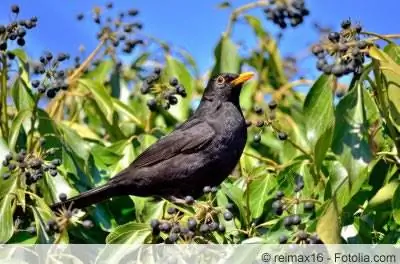
A short-term environmental and species protection aspect for endangered animal species cannot be achieved from the installation of the Benjes hedge alone. The hedge needs years and sometimes decades before it develops into valuable vegetation. Nevertheless, Benje hedges can take on an important role in a biotope in your own garden.
Creating the hedge with dead wood
If you decide to create the Benje hedge, you should first start by collecting natural materials, especially hardwoods. The wood should be collected near the desired location of the hedge. There are now various options for creating the hedge. Natural fence posts can be created to support the hedge by planting smaller trees or bushes at the future location of the hedge. Alternatively, two rows of stakes can be placed parallel and facing each other to stabilize the trees. The first solution is always optimal if you want live material to already be present in the deadwood hedge. The respective spaces between the supports are now filled with the collected woodcut. Ideally, thinner trees are stacked on top of thicker trees so that a stable wall of branches is created in the long term. Tree cuttings should not be piled up too densely, otherwise the seeds will no longer be able to get enough sunlight for the shoots to form. But it is these that later make the Benje hedge bloom. The dimensions of the hedge can be chosen individually; experts recommend a width of half a meter to one meter and a height of up to around one meter.
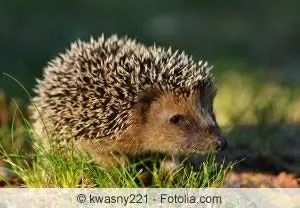
The creation of the hedge runs through
- collecting lumber
- the creation of a supporting structure using piles or plants
- the stacking of deadwood from thicker to thinner materials
- taking into account sufficient sunlight in the hedge
Tip:
If you don't have enough sawn wood from your own garden, you can also get the natural materials you need free of charge from road maintenance depots or as part of forest clearings upon request in order to get to the desired hedge more quickly.
The natural development of the hedge
The Benje hedge goes through different stages in its development. Initially, a bush hedge consists of shoots, which later becomes a herbaceous hedge and finally a single plant. After a few years, a perfect field hedge ultimately emerges. The hedge does not need to be fertilized or cared for in any other way. Because within the hedge, decomposition occurs due to bacteria and fungi. This creates humus that promotes the growth of the Benje hedge.
Frequently asked questions
Is the Benje hedge also suitable for enclosing properties or gardens?
This type of hedge is not suitable for this purpose, as it is rather time-consuming to create and for this reason alone, a classic hedge is more suitable as a privacy screen for your own garden.
How can you create a Benje hedge?
First, you should identify the exact location of the hedge and collect the tree and hedge cuttings that occur in the garden near the future location. Smaller trees and bushes are then planted on the future hedge section, which practically act as natural fence posts.
In expert circles, this process is called initial planting. When the natural fence posts are in place, the branches and twigs from the tree cuttings are piled up to a height of one meter between them. When creating a Benje hedge, it is important to ensure that thicker branches are at the bottom and thinner branches are higher up. This ensures the greatest possible stability.
It is also important to ensure that the individual tree cuts are not stacked too close together. Only if the bushes lie loosely on top of each other can sufficient sunlight reach the seeds and berries so that the hedge can later germinate and bloom. A lot of patience is required from planting a Benjen hedge to the finished property demarcation.
Benefits that arise from creating Benje hedges
Using trimmings is very environmentally friendly. This is how Benjes recognized a very valuable biomass in the cutting waste. In addition, a Benje hedge is a very valuable habitat for many different animals. They settle in the leaves on the ground and a whole range of birds find a safe nesting place in the hedge itself.
In the past, as now, the Benjeshecke is also considered a nature experience for youth and children's groups, because they can experience how waste is created into a new living space and an important design element in landscaping.
Nature conservation is an issue that concerns each of us today; this was Benjes' basic idea. In his work The Networking of Habitats with Benje Hedges is a very humorous and, above all, informative book that anyone interested should not miss.
Here Benjes describes in detail how you can create a Benje hedge and what benefits it offers.

